 There can be lots of barriers to children and young people accessing education effectively. It can be hard to know what strategies to try. We hope you will find something to help your pupils on their journey from nursery through primary and secondary school.
There can be lots of barriers to children and young people accessing education effectively. It can be hard to know what strategies to try. We hope you will find something to help your pupils on their journey from nursery through primary and secondary school.
These questionnaires help you to think about your child's progress at particular stages of development.
The Moving On To Nursery questionnaire is for children aged 2½ to 3½ years old who are about to start nursery. It will help you to teach them the skills they need to take part in nursery.
The Moving On To School questionnaire is for children who are about to start school. It will help you to teach them the skills they need to take part in school.
Don't worry if your child is not meeting all the milestones. The questionnaire will provide you with ideas and activities to help achieve these skills. Further resources are available throughout KIDS. If you are worried speak to your Health Visitor or nursery staff.
 Children in Scotland usually start Primary School when they are between 4½ and 5½ years old. This can be an exciting time for children and their families. It can often be overwhelming too. There are lots of things you can do to help your child with moving on to Primary School. On this page, you will find lots of ideas and activities you can use. Starting to think about what your child will need to do when they start primary school will help you too. Make sure you spend time playing with your child to help them develop the skills they need. This video tells you all about the resources on this page and how to use them. It also has some other tips for teaching your child new skills.
Children in Scotland usually start Primary School when they are between 4½ and 5½ years old. This can be an exciting time for children and their families. It can often be overwhelming too. There are lots of things you can do to help your child with moving on to Primary School. On this page, you will find lots of ideas and activities you can use. Starting to think about what your child will need to do when they start primary school will help you too. Make sure you spend time playing with your child to help them develop the skills they need. This video tells you all about the resources on this page and how to use them. It also has some other tips for teaching your child new skills.
 Going to secondary school is an exciting time. Like any big change you might be a little bit nervous too. On these pages you will find information and activities to help you prepare for this change. There is information and resources to help you manage any anxiety you might be feeling. There is advice about organisation skills such as time management, organising for your school day and finding your way around. There is also a section on life skills. These are the basic skills you need to be independent such as tying your own tie, making a snack and managing your own money.
Going to secondary school is an exciting time. Like any big change you might be a little bit nervous too. On these pages you will find information and activities to help you prepare for this change. There is information and resources to help you manage any anxiety you might be feeling. There is advice about organisation skills such as time management, organising for your school day and finding your way around. There is also a section on life skills. These are the basic skills you need to be independent such as tying your own tie, making a snack and managing your own money.
 Occupational Therapy Resources for Schools
Occupational Therapy Resources for SchoolsJoining in (participating in) every day activities (occupations) improves wellbeing. Taking part in occupations helps you to live a safe, healthy and happy life. For children and young people participating in Education is one of their occupations.
There is a connection between 'the person', 'the occupation' and 'the environment'. Making changes to the occupation and/or the environment can improve participation and wellbeing. Thinking about the child/young person's motivation, interests, values, roles, habits, routines, learning style, skills, strengths and resilience can also help us to improve participation and wellbeing.
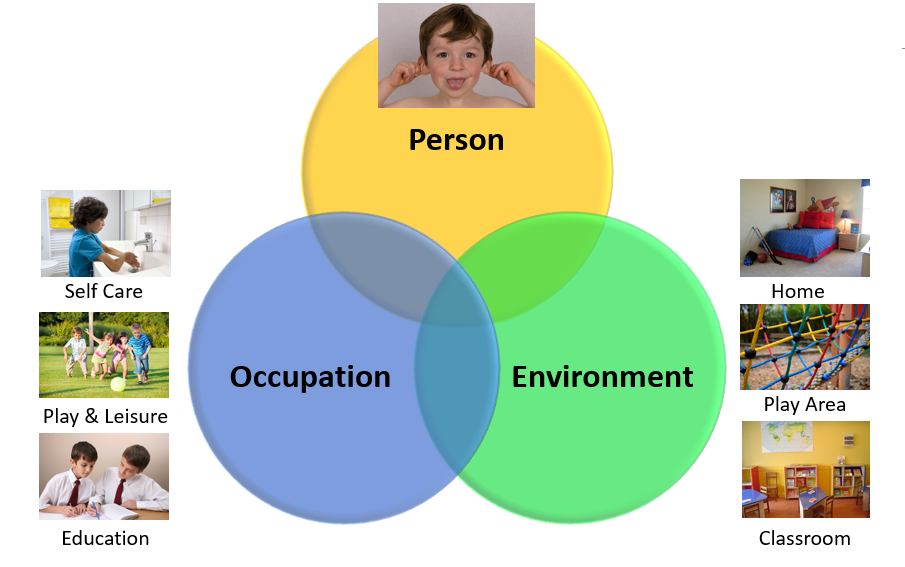
The resources below are divided into person, occupation and environment categories. There are examples of things to think about and strategies to try which can be helpful for lots of children and young people.
We all have our own beliefs, motivators, learning styles, strengths/resilience and vulnerabilities. These can all impact on participation and wellbeing.

Everyone has their own likes and dislikes. What motivates them to persevere with an activity when it is challenging is different for each individual. For most children play is motivating.
Goal setting can help you to empower your pupils to make changes in their life. Talking about what is important to your pupil, their family and you to agree on shared goals ensures you are all motivated to put in the work required to make the changes needed.
Everybody learns in different ways. There are three main ways of learning: doing (kinaesthetic), watching (visual), and listening (auditory). Everyone has their own preference of how they learn best and you and your pupil may vary in these preferences. You may need to help your pupil in different ways by showing, telling or physically doing with your pupil.

Some people need a combination of information to learn best and others cannot cope with a combination of information. Experiment with each of these learning styles and find what suits your pupil best. Remember that some children cannot listen and look at the same time so you might need to show your pupil and then tell your pupil rather than showing and telling at the same time.
Having a routine can help with lots of different things, like sleep and regulating emotions. It helps if children and young people can do a variety of different activities through the day. Following a routine in an education environment can help to make situations predictable which can be helpful for many children and young people. Using visual timetables or planners can help pupils in a variety of different ways.


 Technology can be useful too. Most phones have alarms and calendars that pupils can use to help them stick to their routine. Setting alarms and reminders can help to keep them on track. Encourage them to use these throughout the day not just at school.
Technology can be useful too. Most phones have alarms and calendars that pupils can use to help them stick to their routine. Setting alarms and reminders can help to keep them on track. Encourage them to use these throughout the day not just at school.
There are also other apps out there that might help including:
Participating in meaningful occupation improves health and wellbeing. Occupations are the activities that we want and need to do every day. They include self-care, work/education and play/leisure. By making changes to the occupations children and young people participate in can improve participation, health and wellbeing.
No one will ever learn any new skills if they don't take part and practice. Sometimes you need to have a go and make mistakes so that you can learn. It is important that children and young people are supported to join in with everyday activities from an early age. This gives them the best chance of reaching their potential and becoming independent adults.

Some children/young people will always need others help for some or all of their occupations and practice will not help them to develop skills. Taking part is also important for these children/young people as being involved in their own care to the best of their abilities can have a huge impact on their well-being.
 There are lots of ways that you can think about making changes to the occupation or task.
There are lots of ways that you can think about making changes to the occupation or task.
 Think about when you are trying to learn a new skill. If the task is too easy it doesn’t pose a challenge and you get bored quickly. If the task is too challenging then you become frustrated and may give up.
Think about when you are trying to learn a new skill. If the task is too easy it doesn’t pose a challenge and you get bored quickly. If the task is too challenging then you become frustrated and may give up.
The same is true for children. We need to give each child the ‘just right’ challenge, not too easy or too hard. Both the principles below can help you to get the challenge ‘just right’ for your child. You can also make the activity easier or harder.
When teaching your child a new skill (e.g. using a fork, tying their laces, making a cup of tea, skipping with a rope, using scissors etc.) it helps to break the activity down into manageable chunks. You can then teach one chunk at a time, make up a visual aid using photographs or symbols or make a sequence checklist depending on what suits your child, or use adaptive equipment to help with a specific step. You can also look at each of the steps in turn to identify where things are going wrong for your child/young person.
Think about making a cup of tea, this activity can be broken down into lots of different steps. The steps may vary given the environment, what order you like to do things in (milk first or last?) but generally they remain the same. Once you have learned the key components of a task, you then learn how to do the task in different environments.
Let’s break making a cup of tea down into steps.
 Place the tea bag in the mug/teapot.
Place the tea bag in the mug/teapot.Here are some examples of how you can use these steps to help your child to learn a new skills.
Use photos or symbols to aid learning.

Use checklists as reminders of the sequence of steps.
These could be written lists with boxes to tick when steps are completed. Or you could combine the checklist with photos or symbols.

Focus on teaching one step at a time.
Use adaptive/alternative equipment for the different steps.
In the making tea example you could use:

Writing is the most common method for recording your learning within our education system. This section includes topics such as getting ready to write, holding a pencil, drawing, posture and positioning, strategies to support those who are left hand dominant and alternative tools that can be used.
Children learn to write at school but there are lots of things they need to do first. It is important for them to have strong bodies and arms. They need to have strong hands and fingers. They need to be able to make marks and draw. They need to see letters and words around them. They need to see you write in everyday life.
Before I Learn to Write I Need To:
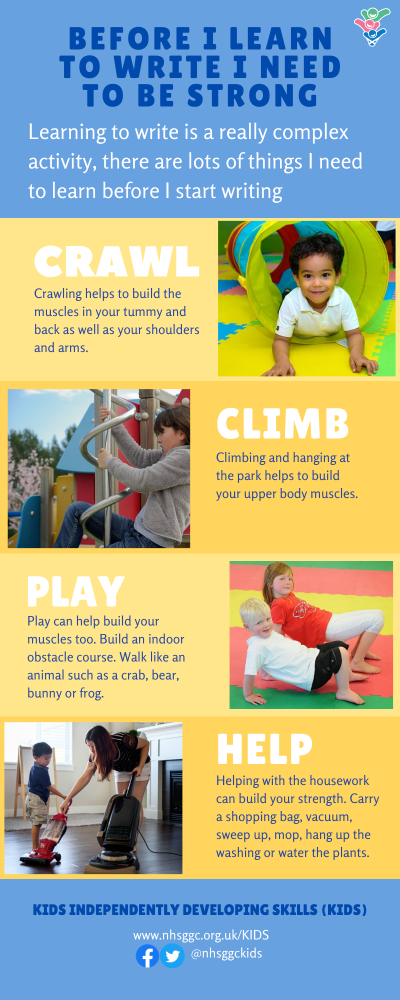
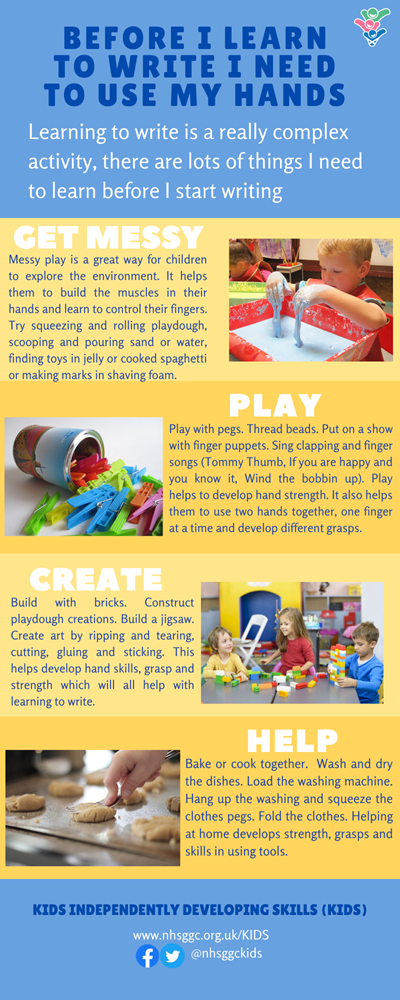


Pencil grasp is only one part of handwriting. In nursery and school a variety of ways of holding a pencil will be seen. Most children develop a pencil grasp that is comfortable for them. The type of pencil grasp your pupil uses is only a problem if it is making writing difficult to read, slow, painful or tiring.
a pencil will be seen. Most children develop a pencil grasp that is comfortable for them. The type of pencil grasp your pupil uses is only a problem if it is making writing difficult to read, slow, painful or tiring.
Children need to be able to draw the 9 pre-writing shapes. These shapes put together in different ways make up all the letters of the alphabet as well as the numbers. This video explains what the pre-writing shapes are. It shows you how to help your child practice these shapes.
Once children have learned how to write there are some general hints and tips that can be useful. Posture and position is important for writing. You can find out more in the Comfortable Learning section. You can also find out about small aids that can help with writing such as sloping boards. People who are left hand dominant may need to use different strategies when writing.
useful. Posture and position is important for writing. You can find out more in the Comfortable Learning section. You can also find out about small aids that can help with writing such as sloping boards. People who are left hand dominant may need to use different strategies when writing.

Developing scissor skills is an important milestone in a child’s life. By learning to use scissors they practice using a tripod grasp (using thumb, index and middle finger together) which then develops into the ideal grasp for writing. It is important that the child uses the appropriate scissors for their dominant hand (left or right handed scissors).
The nursery or school environment can have an impact on how a child/young person participates in learning activities. By thinking about and making changes to the environment you can have a big impact on participation. Improving their participation can have a positive impact on their wellbeing.
We need to make sure our sensory needs are met before we can take part in learning activities. Think about when you learn new skills, it is difficult to do this if you are distracted by noise, smells or temperature. If your sensory environment is not right for you then it will be hard to learn. Making changes to the environment can improve how you take part.
Here are some resources to help you think about changing the environment to help children and young people to participate.
You can use the Classroom Environment Checklist to review your environment and identify changes you can make. Small changes can make a big difference.

Information on each sensory system is available in 3 different age ranges. Complete the questionnaire most appropriate for your pupil's developmental level. For example, if your 6 year old has an intellectual disability and is functioning at age 2 years, the strategies in the 2-5 year old questionnaire will be more helpful.
Our eyes take in information from the world which then goes to the brain. This is not the same as how well we see. If you have concerns about your child's ability to see things properly please take them to an optician for an eye test. Some people might become overwhelmed by visual information. They might find lights too bright or a room too distracting to work. They might have to close or cover their eyes. Other people might not notice things in the environment. They might seek out visual input like shiny, spinning toys or stare at things intensely.
If you think your child or young person processes visual information differently you can:

Our auditory system is our sense of hearing. We take information in from our ears. Some children might become overwhelmed or upset by lots of noise. This is common and part of normal development, but some people can remain sensitive to noise. This can stop them taking part in activities. Some people might seek out noise. They might listen to music or watch the TV with the volume turned up. Listening to the world around us helps us make sense of where we are.
If you think your child or young person processes sound differently you can:

Our touch system picks up information about our environment from sensors in our skin. These give us information about differences in things we touch. Some people can be very sensitive to touch. They might dislike certain textures or labels and seams inside clothing. Other people might not notice touch. They don't notice when their shoes are two sizes too small or may feel pain differently.
If you think your child or young person feels touch differently you can:

Our senses of smell and taste are closely linked, as they follow the same pathway through the brain. Some people might become upset by smells that no one else can smell. Other people might seek out smells and smell objects or people. Processing smell differently can make us refuse to eat different food. We all have definite sensory preferences about tastes we like or dislike. Some people might only eat bland food and find it difficult to eat different foods so have a limited diet. Other people might choose to eat intense flavours like spicy or sour foods. They might lick objects which are not food.
If you feel your child or young person processes taste or smell differently you can:

Proprioception is the awareness of body position and movement or knowing where your body is in space. Proprioceptive receptors are in the muscles and joints. They send messages to the brain to tell it where your body parts are in space. They tell you how much force or pressure your muscles are using. This helps us to know which position our body is in. Some people might bump or crash into things or hold their pencil too tightly. They might be too rough when playing with friends or chew on objects like clothing or ends of pencils.
If you feel your child or young person processes proprioceptive information differently you can:
The vestibular system gives us information about balance and movement. When your head and body move, fluid in your inner ear moves too. This gives your brain information about how you are moving. Some people process vestibular information differently. They might spin or move more than other people. Other people might avoid lots of movement. They might not like it when their feet leave the ground.
If you think your child or young person processes balance and movement information differently you can:
Sense of how the body is feeling
Interoception is the sensory system which gives us information about the internal sensations in the body and how they link with emotions. It helps us work out how the body is feeling.
The receptors for this system are throughout the body in organs like the heart, lungs, stomach, bladder and skin. They pick up information and send it to the brain where it is translated into feelings relating to body comfort like hunger, needing the toilet, sleep, being too hot/too cold. It also helps us feel our emotions.
If you process this information differently you might:
 Not know when you are full or when you are hungry/thirsty
Not know when you are full or when you are hungry/thirstyIf you have difficulty understanding these signals it could be because of how you process interoceptive input. There are however lots of different reasons why you might have difficulty understanding these signals. If you have any concerns about other possible causes please speak to your GP or Health Visitor.
What you can do:
There are still lots of discussion about what helps improve interoception. There is no good evidence that any particular strategy is effective. There is some evidence that mindfulness can help. It is important to rule out any possible underlying medical causes for the issues first if you are concerned.
Things which may help:
For example:
Help them make the connection so that the next time they have that feeling they are more confident in knowing what it means.

Draw an outline of a body and identify words that might go with that body part. Help your child work out what words they associate with sensations- remember they might not be the same ones you would use!
 How my body feels when it is hungry
How my body feels when it is hungry
Notice: my brain feels fuzzy, my muscles feel shaky and my tummy is rumbling.
Connect: I usually notice these feelings together when I’m hungry.
Regulate: I’ll eat something.
Outcome: I notice the fuzzy head, shaky muscles and rumbling tummy have gone. I was right! I must have been hungry.
 How my body feels when it is angry
How my body feels when it is angry
Notice: my brain feels swirly, my muscles feel tense, my heart is beating fast and my breathing is fast. My skin is hot and sweaty.
Connect: I usually notice these feelings together when I’m angry.
Regulate: I know this feeling will pass. I won’t feel like this forever. I will try deep breathing and finding a quiet space. This usually helps me.
Outcome: I notice the feelings are gone.
For younger children:
Listening to my Body by Gabi Garcia
Having a good understanding of pupils likes, dislikes and triggers is important. Knowing these can help pupils to participate in the school environment. You can use the Sensory Questionnaires, your observations, information from the pupil and their family to write an 'All About Me'. Having a quick reference will help you to reduce stressful experiences and promote coping strategies.
Top Tips for 'All About Me'
You can use our blank template or look at the extra guidance to see what to include.
All brains are different and therefore there are different ways to listen. Some children can sit with their legs in a basket, with their hands still and look at you while they are listening. Other children can find concentrating on staying still or giving eye contact while they are listening challenging. They might need to move, fidget or look away to take in what you are saying. Our bodies need to be comfortable so that we can listen. This is different for everybody. You could print out our poster to display and remind everyone that good listening looks different for everyone.
NHSGGC Occupational Therapists worked collaboratively with Educational Psychologists in East Renfrewshire to develop a resource for Education staff. You will find more resources on the Understanding and Supporting Sensory Processing in an education context page.
LEANS is a free programme for mainstream primary schools to introduce pupils aged 8-11 years to the concept of neurodiversity, and how it impacts our experiences at school.
 Theraputty is a fun activity that can be used to strengthen muscles in weak hands. It can also be used as a fidget tool for people who need to keep their hands busy.
Theraputty is a fun activity that can be used to strengthen muscles in weak hands. It can also be used as a fidget tool for people who need to keep their hands busy. 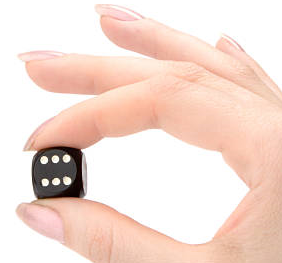 In-hand manipulation is the term used to describe the ability to move a small object around within a single hand. It is an essential component of the development of fine motor control. Good fine motor control enables you to carry out such tasks as holding pencils, fastening small buttons, using cutlery and being able to tie your shoelaces.
In-hand manipulation is the term used to describe the ability to move a small object around within a single hand. It is an essential component of the development of fine motor control. Good fine motor control enables you to carry out such tasks as holding pencils, fastening small buttons, using cutlery and being able to tie your shoelaces.
The In-Hand Manipulation Programme is a good way of helping in-hand manipulation to develop. The programme contains exercises which should be carried out by both hands in turn, but always start with the dominant or preferred (writing) hand. These skills develop in a particular order and the exercises suggested are listed in sequence.
 The following activities have been recommended as they allow individuals to practice the essential fine motor skills required to carry out day-to-day functional tasks, both at home and in school.
The following activities have been recommended as they allow individuals to practice the essential fine motor skills required to carry out day-to-day functional tasks, both at home and in school. The FIZZY and Clever Hands programme has been developed by therapists in Kent Community NHS Trust.
The FIZZY and Clever Hands programme has been developed by therapists in Kent Community NHS Trust.
 The FIZZY and Clever Hands Programmes are recommended by occupational therapy as programmes for schools to use to assist in the development of motor skills for those children who find this challenging. It can be helpful to use this programme when you are concerned about a child's motor skills. It can help you to establish whether or not a referral to occupational therapy is required or can be used while a child is waiting to be seen by occupational therapy.
The FIZZY and Clever Hands Programmes are recommended by occupational therapy as programmes for schools to use to assist in the development of motor skills for those children who find this challenging. It can be helpful to use this programme when you are concerned about a child's motor skills. It can help you to establish whether or not a referral to occupational therapy is required or can be used while a child is waiting to be seen by occupational therapy.A Guide to Using the Programme
Fizzy Body Awareness and Co-ordination Level 1
Fizzy Body Awareness and Co-ordination Level 2
Fizzy Body Awareness and Co-ordination Level 3
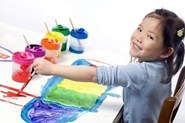 Many young children speak dysfluently at times, especially when they are under some pressure to speak. There is no exact point at which normal dysfluency becomes stammering though there are features which enable us to decide between normal non-fluency and stammering.
Many young children speak dysfluently at times, especially when they are under some pressure to speak. There is no exact point at which normal dysfluency becomes stammering though there are features which enable us to decide between normal non-fluency and stammering.
Normal non-fluencies are usually relaxed repetitions, often of whole words either at the beginning of a phrase or when a child is thinking of how to finish a sentence.
There is a greater risk of stammering developing when the child often gets stuck on words, prolonging or repeating part of the words or putting excess effort into finishing them. It is also a concern when the child seems aware of and upset by their dysfluencies. However, one of the things that make it so difficult to say with certainty whether or not a child stutters is that there can be so much variation from day to day and in differing situations.
 By now the child who stammers may have been stammering for some time. Some children may stammer with obvious physical tension and some may have mild, infrequent non-fluencies such as repetitions and sound prolongations.
By now the child who stammers may have been stammering for some time. Some children may stammer with obvious physical tension and some may have mild, infrequent non-fluencies such as repetitions and sound prolongations.
A particular concern for teachers is the child’s reactions to his stammering and the reactions of others in the classroom. How should the child be expected to participate in class? The answer to this question depends on the individual child. At one end of the scale is the child who may be quite unconcerned and happy to participate like any other child; at the other end there is the child who will avoid speaking at all costs. Most are somewhere in between. If the child is attending Speech & Language Therapy then the therapist will let you know about particular strategies. It is important for the parents and teachers involved to have a discussion with the child to find ways to encourage them to participate without putting too much pressure on them. Sometimes participation requirements become part of the child’s IEP/ASP.
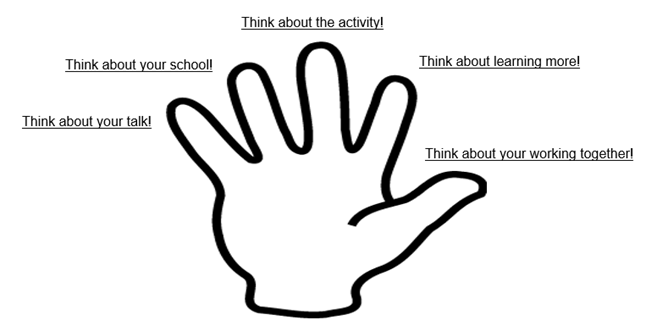
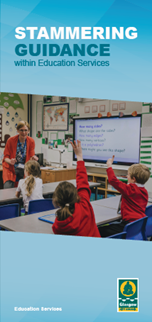
Young people with speech, language and communication needs, often struggle with learning and retaining new vocabulary in secondary schools. They need regular revision and repetition of new concepts.
Most classroom teaching at secondary school level, is delivered orally. Teachers talk through new material, give verbal instructions, students ask questions out loud to clarify points or find new information. In addition feedback or revision of previous learning is most often given verbally. If a young person has compromised speech, language or communication they may struggle to understand and learn appropriately within a predominantly oral learning environment.
The good news is that simple adaptations to the curriculum, learning environment and the language used by teachers in the classroom can make a big difference.
Six approaches have been shown to work effectively in reducing the impact of speech, language and communication needs (SLCN). Many of these will be familiar to you however the best results will be achieved if all are used consistently across curricular areas.
 www.ambitiousaboutautism.org.uk
www.ambitiousaboutautism.org.uk
www.bestbeginnings.org.uk/baby-buddy
 www.autism.org.uk/what-we-do/scotland
www.autism.org.uk/what-we-do/scotland
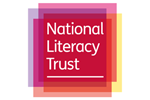 www.literacytrust.org.uk/talk_to_your_baby
www.literacytrust.org.uk/talk_to_your_baby
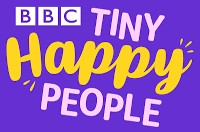 www.bbc.co.uk/tiny-happy-people
www.bbc.co.uk/tiny-happy-people
Glasgow City Youth Health Service offers confidential, personalised support for young people aged 12-19 years in Glasgow City.
They support young people with their health and wellbeing and to help them achieve their full potential.
They support with: